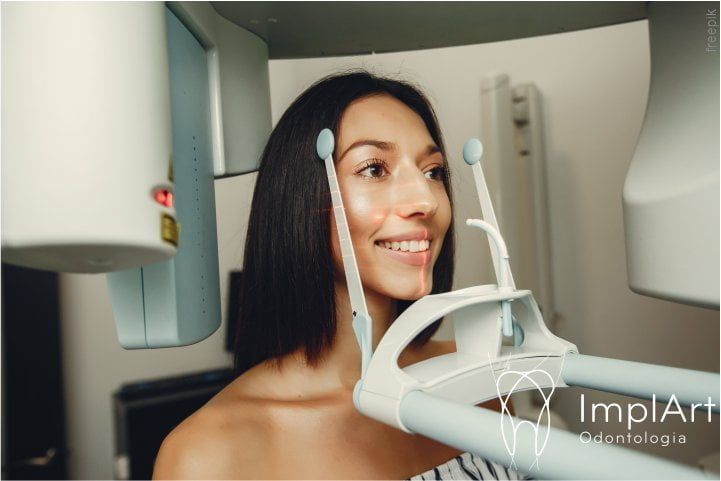Digital radiology center at the ImplArt Clinic
For your convenience, the ImplArt Dental Clinic has a digital radiology center for carrying out radiological examinations, which are essential for diagnosis and planning/monitoring various dental treatments. Diagnostic examinations certainly play a key role in the planning of an excellent dental treatment by an implant dentist. They are indispensable for planning bone grafting, periodontal grafting, dental implants, total impl ants and protocol prostheses.
In this sense, digital radiology at the ImplArt Clinic is linked to the One Stop Solution concept, where patients can carry out everything from diagnostic examinations to complete dental treatment within the complete structure of the Dental Clinic.
Radiology Center of the ImplArt Dental Clinic
Digital radiographs and examinations at the ImplArt clinic help with rapid diagnosis and treatment planning
The ImplArt Clinic’s digital radiology center facilitates diagnosis and speeds up the start of treatment, since patients don’t have to travel to another address to have their tests carried out.
The ImplArt radiology center is equipped with a state-of-the-art digital x-ray machine (manufactured by Dabi Atlante), which enables digital panoramic x-rays and computed tomography, both with real-time image results.
With these high-precision tests, the diagnosis is made quickly and reliably. They also support treatment planning, avoiding wasted time, unnecessary procedures and possible surgical accidents.
Digital radiography is a way of capturing images by emitting x-rays, but with digital sensors rather than traditional film.
Advantages of Digital Radiology
There are many advantages to using digital radiography:
- Patient exposure to radiation is much lower in digital radiology compared to traditional film.
- The patient doesn’t have to repeat the examination until the image is good.
- Diagnoses are faster and more accurate, as the image captured in digital radiology has excellent resolution and the dentist can view it directly on the computer screen (no need to wait for it to be developed).
- It allows small details such as tooth or root fractures to be analyzed. The dentist can enlarge the image when necessary.
- It allows interaction between dentist and patient, since with the digital image on the computer screen, it is possible to better discuss the diagnosis and treatment planning.
- It can be filed in the patient’s chart and opened by any member of the dental team involved in planning and treatment.
- The test is sustainable, as there is no need to print film or use toxic chemicals to develop it.

Digital radiology – Panoramic radiography
A radiological examination used to visualize oral structures. Here are some situations in which it is very useful in dentistry:
- Visualize the general condition of the supporting structures of the teeth (bone volume, tooth roots, periodontal ligaments, nerves, etc.)
- Diagnosing periodontal disease, even at an early stage
- Diagnosing advanced caries and other dental pathologies
- Analyze previous treatments carried out by our team or in other clinics
- Routinedental check-up
- Checking the position of wisdom teeth for extraction
- Planning tooth extraction
- Analyzing the bone levels of patients who are candidates for dental implants
- Monitoring the post-operative period of dental implant patients
- Check that the prostheses on implants fit accurately
- Monitoring the maturation of bone grafts

Computerized Tomography (CT-scan)
Thishigh-precision radiological examination, available at the ImplArt Clinic’s Digital Radiology Center, is designed to visualize bone structures. In dentistry, it is very useful because the three-dimensional image makes it possible to analyze teeth, bones, joints, occlusion, soft tissues, nerve pathways, etc. Here are some of the main uses of CT in dentistry.
- Diagnosing periodontal diseases, even at an early stage.
- Measuring bone volume for planning dental implant surgery. Knowing the exact measurements of the bone tissue is an extremely important factor when planning dental implant surgery, because in this way it is possible to choose implants with dimensions suited to the needs of each patient and also to respect the limits of the tissues in order to avoid affecting sensitive structures such as nerves.
- CT assists in what we call computer-guided surgery, a technique that makes surgery precise and less invasive, and therefore with the expectation of a quicker and smoother recovery.
- Monitoring the implant healing process (osseointegration).
- Identify possible problems with the implant, especially peri-implantitis (infection around the implant that can lead to mobility or falling out).
- Identify fractures or defects in the maxilla or mandible that affect the health and stability of teeth or implants.
If you have any questions, please contact us or come and visit us. We at the ImplArt Dental Clinic will be happy to help you.

